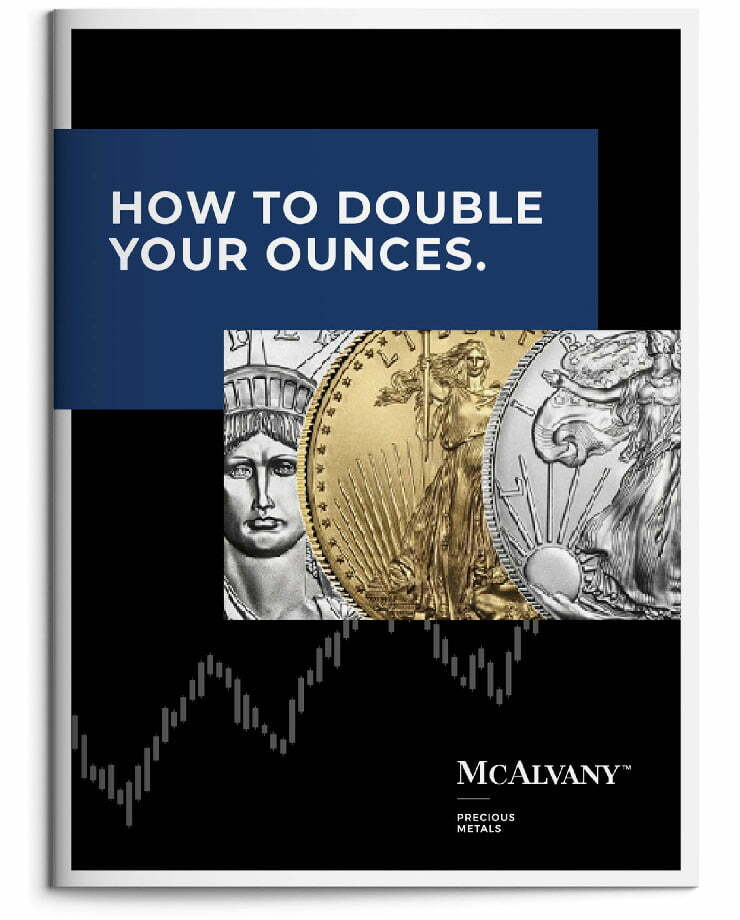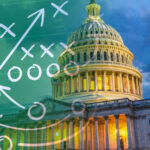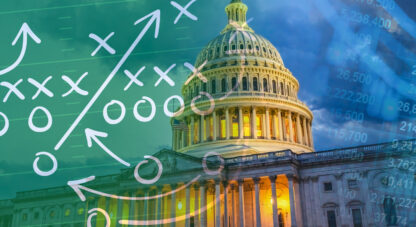The Uncertainty Variable
In HAI‘s view, the current uncertainty variable for markets and the economy ranks as off the charts. That’s no insignificant matter given that the natural human reaction to uncertainty and volatility is to freeze up. As such, a potential freezing up of the economy this summer is a clear and present risk. A corresponding resumption of the stock market downturn therefore looms as a very real threat despite what is now nine straight days of a recovery rally for the benchmark S&P 500.
This week, Siebert Financial Chief Investment Officer Mark Malek described the recent uncertainty in markets perfectly. He said uncertainty in April “was an extreme for the textbooks, [it was] systematic risk in its purest form.” He added that the resulting volatility “has been wholly different from anything we have experienced in the past, and it indiscriminately spread through all sectors and asset classes like a wildfire, constantly being fueled by random sound bites and shifting policy moves.” Again, uncertainty and volatility tend toward a freezing up of risk-taking, which translates to a slowing risk-off posture in the economy broadly.
This week, the Elliott Wave Financial Forecast (EWFF) underscored warnings of the bearish implications of uncertainty and its resulting volatility. According to EWFF, volatility itself can be used to identify bullish and bearish market regimes. For example, the market advance from October 13, 2022 to February 19, 2025 saw a miniscule number of ±2% daily changes in the S&P 500 that amounted to a mere 3% of all trading days. By contrast, since the February 19th market peak, that number of ±2% trading days for the benchmark index has jumped to 20%, a number consistent with the more amped-up volatility of a bear market regime.
The cautionary tone over the negative impact of the present state of extreme policy and economic uncertainty was also echoed this week by HAI-favorite economist and former Merrill Lynch star David Rosenberg. As Rosenberg put it, in typically colorful terms, “if I’m right, we’re finally going to get the recession that never came in 2022 and 2023… I know that it’s the boy who cried wolf, but remember that the wolf does show up at the end of the story.”
Like Rosenberg, HAI agrees the wolf is now circling the U.S. economy. But HAI also loudly (and wrongly) cried wolf to anyone who would listen in 2022-2023 during the last Fed rate hiking cycle. So, in hopes that we accrue wisdom and age gracefully, HAI will take this incoming recession as a very real possibility, but not a foregone conclusion.
Here’s why: The U.S. has an acute debt and deficit problem. In fact, on a trailing 12-month basis, U.S. “true interest expense” (interest + entitlements) is running at an unsustainable 108% of tax receipts. That vulnerability has already sent repeated tremors right to the heart of the post-1971 global economic/monetary system—the U.S. bond market. Furthermore, we know that in our increasingly hyperfinancialized economy that policymakers have built over recent decades, the stock market must rise for U.S. consumer spending to rise, and in a 70% consumer spending-driven economy, stocks and consumer spending must rise to keep U.S. GDP and, by extension, U.S. tax receipts healthy.
If we have a recession amid an already acute fiscal problem, with inflation already well above target and inflation expectations at multi-decade highs, we run the risk of a recession in which bond yields actually rise as Treasuries no longer qualify as a “risk free” safe haven asset. That, folks, is a recipe for a terminal U.S. debt spiral as higher interest expenses drive higher government outlays on lower tax receipts due to the recession hitting the stock market, consumer spending, and GDP.
That is the cataclysmic self-reinforcing bear case for the stock market. But will policymakers allow that to happen? Maybe, and we should prepare for it, but, alternatively, policymakers might buckle under the pressure (as we’ve seen so often in the recent past) and try an alternative path.
We’ve already seen Trump and company ease their tone and tariff posturing in the face of both equity and bond market buckling. This week we had both President Trump and Treasury Secretary Scott Bessent hint at what could be a massive inflationary stimulus to both the U.S. economy and the stock market. Trump and Bessent suggested that tariff income could be used for tax relief, noting that taxes could be “substantially reduced” or even “completely eliminated” for Americans making less than $200,000 per year.
Now, again, uncertainty reigns supreme here, but if Trump applied targeted “smart” tariffs that could raise sufficient revenue without necessarily cratering the economy, he could mathematically (theoretically) allow for a very significant tax cut or tax elimination for 90-95% of Americans while keeping government revenue neutral. In HAI‘s view (at least in the short-term), one could reasonably expect such a policy move to significantly boost the economy, the stock market, and—on a lag—inflation.
After all, as former Treasury Secretary William E. Simon once quipped, “the American people have a love-hate relationship with inflation. They hate inflation but love everything that causes it.” So if Trump’s first thought on how to truly MAGA looked destined to result in a very unpopular deflationary crash of the system a few weeks ago, perhaps a more politically popular (at first) inflationary approach is plan B.
A combination of tariffs, massive tax cuts, aggressive Fed rate cuts, and perhaps some form of Fed yield curve control (or its functional equivalent) could keep the music playing for the U.S. economy—and keep the markets dancing. The likely release valve in such a scenario, however, would be inflation.
Again, in a world of profound uncertainty in the short term, HAI is just speculating on potential outcomes that could span from deflationary crash to inflationary crack-up boom. In HAI‘s view, we have to be on high alert for all of these potential outcomes.
However, in HAI‘s view, the one constant so far from the Trump administration seems to imply that to MAGA, this administration must find a way to restructure the post-1971 dollar-centric global financial/monetary system in such a way that allows the dollar to structurally weaken and, as a result, allow American manufacturing to revitalize.
This week, in his interview with Thoughtful Money, David Rosenberg corroborated what has been HAI‘s working assumption for months. Rosenberg said, “on April 2nd [liberation day], when I look through the whole thing, I’m just asking, is Donald Trump actually telling the world, we don’t want to be the world’s reserve currency anymore? Is it just too much of a burden on Main Street? And you start wondering, why has gold been surging? But that’s the hidden message, right? The hidden message is that being the world’s reserve currency has been a burden to Middle America.”
In HAI‘s view—BINGO! Difficult to know the details of the exact course of action, but it sure seems as if the direction of travel for this administration is hard bent toward accommodating the transition from global “dollar recycling” to global “gold recycling” (Treasuries as global reserve asset to gold as primary reserve asset) as a means of weakening the dollar and ultimately revitalizing American manufacturing.
So, while uncertainty is the key and unalterable variable in analyzing the details of the current set of political-, economic-, and market-related questions, what seems far more certain is the ultimate outcome of gold being re-integrated into the new global financial system—with much higher prices implied.
HAI has long been convinced of this outcome of much higher gold prices, but this week Rosenberg offered further confirmation of another long-held HAI conviction—the opportunity in gold mining stocks. As Rosenberg said, “We’ve actually done a lot of technical work on gold, and we think in the next 3-5 years its going to go to $6,000 an ounce… but the gold mining stocks is, I think, where the really big money is going to be made.”
HAI has an even higher expected target for the gold price but wholeheartedly agrees on the ripe opportunity for truly spectacular gains in the mining stocks. So far, the gains in gold have been driven by central banks adapting to a more gold-centric future. The Western investor has, as yet, been largely absent the sector. But, as a signpost, when David Rosenberg touts the big opportunity in the oft overlooked and always underappreciated gold miners, HAI believes the Western investor FOMO moment chasing gold miners higher than most assume possible isn’t far off.
Gold is correcting and consolidating massive gains at present. That’s healthy. But when Western consensus increasingly picks up what Rosenberg is laying-down, HAI expects gold and the gold miners to re-engage in an upside move for the ages. While the present uncertainty variable looms large over the economy and financial asset markets, the future of gold and the gold mining stocks shines bright across an inspiringly wide swath of likely outcomes. Despite the current correction, in HAI‘s view, gold is likely still in the early innings of it’s secular bull run higher. It’s got miles yet to go before it sleeps.
Weekly performance: The S&P 500 was up 2.92%. Gold was off 2.43%, silver was down 3.21%, platinum was off 0.81%, and palladium was up 2.15%. The HUI gold miners index lost 3.20%. The IFRA iShares US Infrastructure ETF was up 3.25%. Energy commodities were volatile and mixed on the week. WTI crude oil was down 7.36%, while natural gas surged 17.76%. The CRB Commodity Index was off 2.73%. Copper was down 3.99%. The Dow Jones US Specialty Real Estate Investment Trust Index was up 3.66%. The Vanguard Utilities ETF was up 1.94%. The dollar index was up 0.58% to close the week at 100.04. The yield on the 10-yr U.S. Treasury was up 7 bps to close at 4.31%.
Have a wonderful weekend!
Best Regards,
Morgan Lewis
Investment Strategist & Co-Portfolio Manager
MWM LLC















